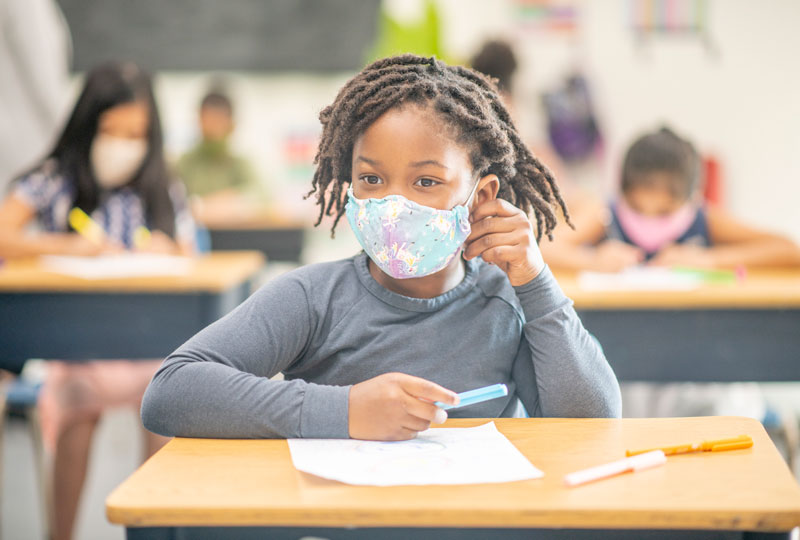Prevention strategies are keeping coronavirus spread in the classroom relatively low.
In the months since the novel coronavirus pandemic reached the United States, school routines have been disrupted. In an effort to slow the transmission of the virus that causes COVID-19, some states and school districts closed schools, then later reopened for in-person classes, and some have shut their doors again in favor of online learning. It’s become common for families to juggle work, school work and school-related activities such as sports, all under changed or changing rules about what can happen safely in person and how to ensure that students don’t catch or spread COVID-19 at school or during their sports teams’ practices and games.
In autumn 2020, many months into the pandemic in the U.S., two pediatric infectious disease specialists at Monroe Carell Jr. Children’s Hospital at Vanderbilt held a webinar reviewing research studies of coronavirus spread at school and through youth sports. Sophie Katz, M.D. and Ritu Banerjee, M.D., Ph.D., aimed to inform teachers, school systems, coaches and others who work in and for schools. Their discussion may also help parents keep children healthy during COVID-19 while attending in-person school and team sports.
Based on many COVID-19 studies done in the U.S. and in other countries, here’s what Katz and Banerjee want parents to know about the spread of the novel coronavirus at school and around team sports:
Prevention strategies work.
The coronavirus generally causes milder illness, or no symptoms at all, in young children, compared with adults. That doesn’t mean children can’t get the virus or that none of them ever become seriously ill. The good news, Katz said, is that daycares and schools are not the main “hotspots” for the virus’ spread. “This means that the school reopening really doesn’t have much of an impact on community transmission,” Katz said.
“It seems like mitigation strategies like wearing masks, washing hands, and keeping desks distanced really do help to decrease rates of transmission in school,” Katz said.
Spread happens more because of activities related to school, rather than in the classroom.
Those rules are apparently limiting the virus’s spread in the classroom. Outside it, however, students, parents, teachers, coaches and others have not used those strategies consistently. “Things like carpools, travel leagues, sports, gyms, locker rooms — where people may or may not go without masks on — and then parties and larger gatherings of people” are where the virus has been spreading, Katz said.
Sports leagues should employ the same prevention tactics that are proving effective in the classroom. “Our Vanderbilt sports medicine colleagues, many of whom sit on committees that are part of the American Academy of Pediatrics, have come up with the following guidance,” Banerjee said:
- Students should stay home if they’re sick or had a possible exposure to the virus.
- When possible, reduce physical closeness and keep six feet of space between players on a sports team. This might mean changing how practices or games are conducted – for example, it’s wise to reduce the number of students in a swimming lane. “Avoid dugouts. Avoid locker rooms,” Banerjee said. “Wear a mask. Student athletes should bring their own equipment, like gloves and bats. Don’t share things.”
- Athletes should adhere to strict hand hygiene. “Hand sanitizers should be readily available after games and practices,” Banerjee said. The American Academy of Pediatrics in December 2020 issued guidance saying that student athletes should wear masks for most sports during practice, competition and on the sidelines.
Virus transmission at home
In one Vanderbilt study of how the coronavirus spreads within a household, “Two-thirds of these children who were found to be COVID-positive had a known contact either in the household or community,” Banerjee said.
“It does seem to spread pretty quickly within a house. And that’s probably because most of us are a little bit more relaxed when we’re at home. I don’t know that anyone really wears a mask when they’re at home,” Katz said.
She’s not suggesting that they do. But there are steps families can take to keep children healthy during COVID-19 when someone in the household has the virus to prevent it from spreading to the rest of the family. Frequent hand-washing, careful disinfecting – and especially physical distance between family members can prevent contagion.
Know the difference between quarantining and staying isolated, to keep children healthy during the COVID-19 pandemic.
Quarantining vs. staying isolated: What’s the difference?
“Isolation is when a COVID-positive person must stay at home for a defined period, which usually is until they’re fever-free for one day, have improvement in symptoms, and it’s been at least 10 days since the onset of their symptoms or their diagnosis,” Banerjee said.
Quarantine is for someone who had a close contact with someone who is infected. Quarantining means staying home and watching for signs of infection in yourself for a certain period of time. In early December 2020, the CDC changed its guidance about quarantine. The updated recommendation is that local health departments may advise people to quarantine for 10 days (rather than 14), or for seven days after a negative COVID-19 test — if local data and conditions support the shorter quarantine period. The quarantined person should continue monitoring themselves for any symptoms for 14 days, Banerjee said.
Banerjee offered this guidance for which children should stay home from school and sports:
- Any child with symptoms, whether or not they’ve been tested. “Ideally we want any child with symptoms to be tested, but they should not come to school if they haven’t been tested yet. They should not come to school if they’ve had a positive COVID test, obviously, and they should not come to school if they’ve been tested and they’re waiting for a COVID test result.”
- “Any child with a household member who’s symptomatic or has a pending or positive COVID test should stay home. They should not come to school. The exception is if there’s a household member who has routine surveillance COVID testing say as part of their job and they’re not symptomatic. And that child could still attend school.”
- “Any child under quarantine because they’ve been identified as a close contact should not come to school until they are cleared according to their school policy,” Banerjee said. Many schools are now following the updated CDC guidelines, which state that people who have been exposed can shorten their period of quarantine to seven days if they have a negative test about five days after their exposure.
When can a student return to sports?
Banerjee described the American Academy of Pediatrics guidance on when it’s safe for a child who had COVID-19 to return to their team’s activities:
- There should be at least a two-week resting period for the student athlete without any exercise or competition.
- Children with any symptoms when they’re physically active, such as chest pain or tightness and/or shortness of breath, should have at least a two- to four-week restriction from further exercise and competition. “This is because we know that the virus that causes COVID-19 has been associated with inflammation of the heart in some collegiate level athletes and also in some adolescents,” Banerjee explained.
- The AAP is strongly encouraging that any child who had a COVID-19 infection be cleared by their primary care physician before returning to sports.
Don’t let down your guard. And get a flu shot.
Katz and Banerjee emphasized that the virus has spread most quickly through social activities outside school.
“We really need to reinforce safe practices in your school communities. No sleepovers, no parties, no restaurants, no large gatherings,” Banerjee said. She acknowledged that everyone is tired of staying apart from each other, and craving traditional school activities and end-of-year holiday gatherings. But she urged adults to avoid giving in to “quarantine fatigue.”
“As a parent, I hate that I have to say no to a lot of the things that my children are asking for, but we just need to reinforce them. Those are the sacrifices we need to make right now.”
Finally, Banerjee said, “We’re cautiously optimistic that we will not see a bad flu year, but we’re still encouraging everyone to get their flu shot. Because if we don’t comply with all of these mitigation strategies and masking and distancing, we could see co-circulation of flu and COVID.”

Staying Safe is Essential. So is Your Child’s Care.
Monroe Carell Jr. Children’s Hospital at Vanderbilt is taking a careful approach to help keep your child and family safe, along with team members. Safety actions follow recommendations by the Centers for Disease Control and Prevention and other trusted experts.
COVID-19 is not the only threat to your child’s health and well-being. Many illnesses and conditions can cause serious problems. Good preventive care and early treatment can save lives. Please don’t delay important healthcare for your child — including all-important immunizations.



